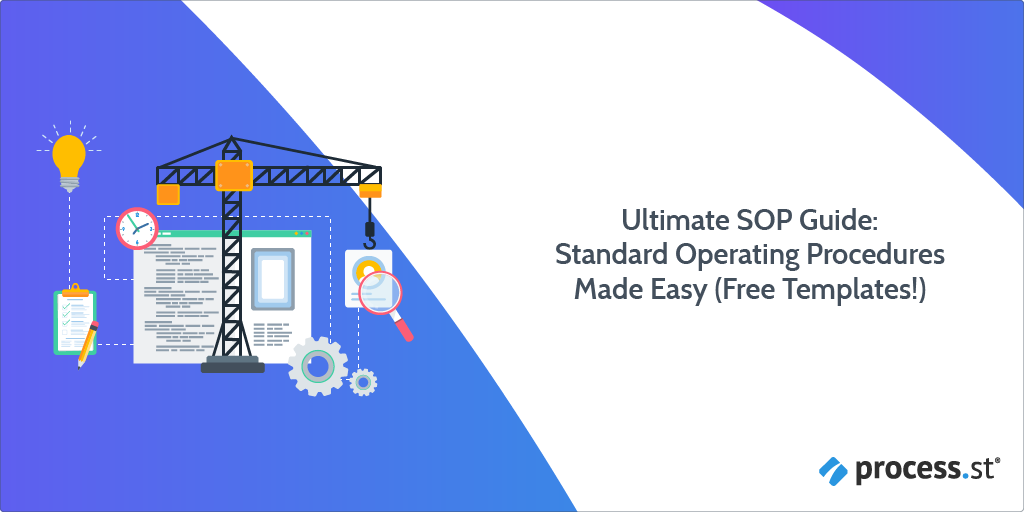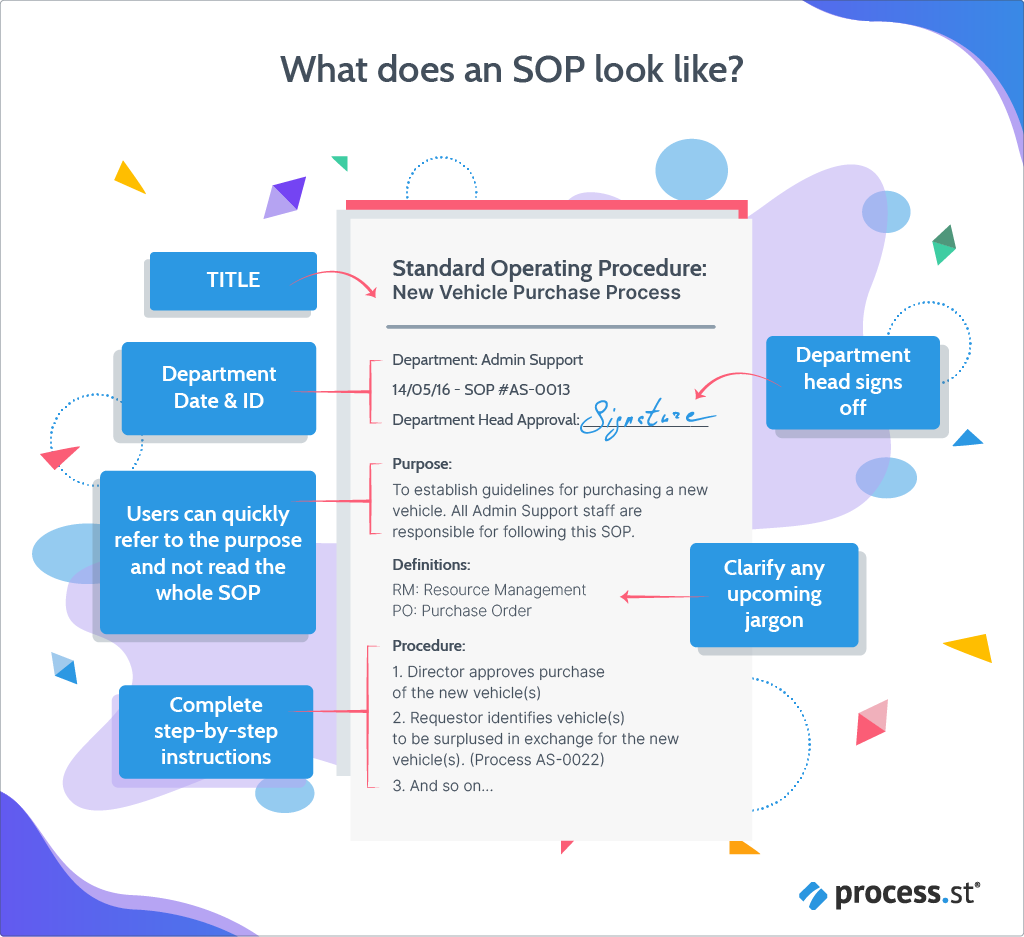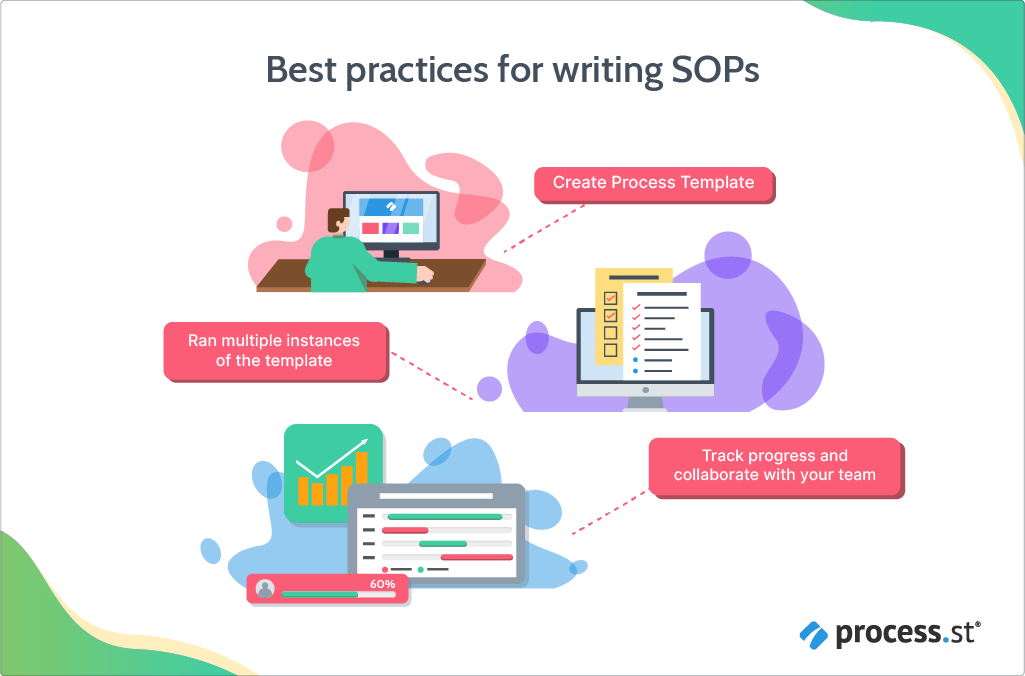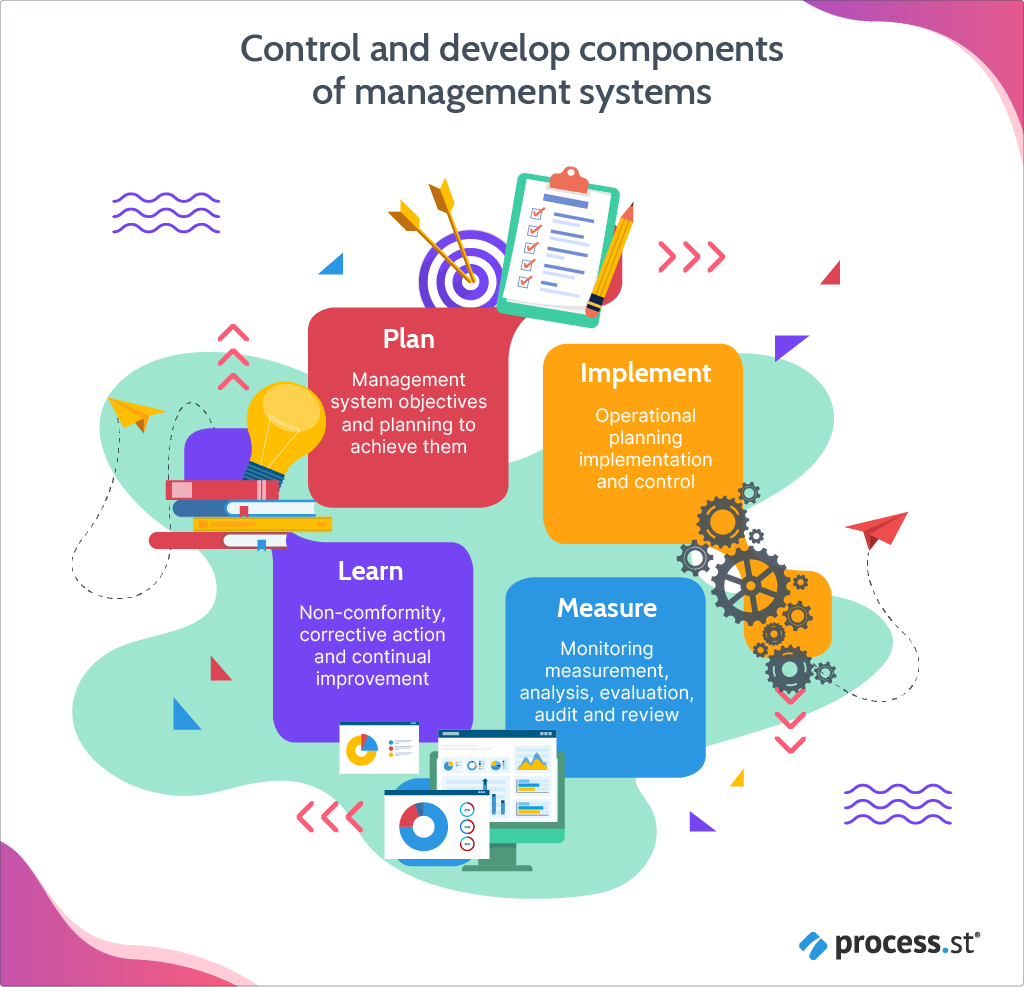
SOPs (often pronounced S-O-P) are basically just another way to think about processes. Specifically, with a focus on formally defining the best way of doing something.
In business terms, that means saving time and money by building a clear, concise set of instructions for all of your internal processes. Policies (or standards) are important too; SOPs are kind of like a hybrid of policy and procedure.
Traditionally, SOPs were useful in principle, but often suffered from being difficult to maintain and crucially, hard to enforce. What good is an SOP if it lives its life sat on a dusty stack of paper forms? Your SOPs should be actionable, and that’s where BPM software like Process Street comes in.
If you understand how to build, maintain, and optimize SOPs with software, you can supercharge your standard operating procedures.
In this article, we want to give you everything you will ever need to know about SOPs, including:
- What is an SOP?
- Importance and benefits of standardizing your processes
- SOPs as a facet of BPM
- How to write SOPs
- SOP management software
- SOP templates
- Auditing your SOPs
- SOP & ISO
- Using Process Street for superpowered SOPs
- More SOP resources
Each section will be as concise as possible, with links out to further reading wherever appropriate. Let’s start with the basics.
What is an SOP?
A standard operating procedure (SOP) is a detailed procedure that outlines the steps needed to complete specific tasks following your company or industry standards.
Technically, any checklist or step-by-step instructions can be referred to as a procedure. For instance, in order to ensure consistency and efficiency, a manufacturing company would provide its employees with precise, step-by-step instructions for them to follow when manufacturing their product.
Standard operating procedures are crucial to operating a business that is consistently meeting quality standards.
What does an SOP look like?

Here’s an example one of our SOP format templates that you can use to quickly and easily build your SOPs:
There are many ways to approach writing an SOP, but one thing to keep in mind is that your SOP should always be easy to follow and specific to your organization. Despite the fact that SOPs are typically written following specific guidelines, there isn’t really a single SOP format that works for everyone. Procedures will vary from company to company and so their SOP format should do the same.
Process Street allows you to create powerful SOP templates for multiple different use cases for this very reason.
For example, check out this procedure for new employee onboarding checklist:
To read further information on the subject, here’s an article we wrote:
Simple SOP Format Guide: How to Write Standard Operating Procedures
Importance and benefits of standardizing your processes
When a company’s processes have been properly standardized, it guarantees consistency, quality, and improves overall productivity.
Some benefits of standardizing your processes include:
- Guaranteed quality
- Improved process understanding for your employees
- Boosted productivity
- Better customer service
- Improved team morale
Here’s an article we’ve written on the subject if you’re interested in learning more:
Why Process Standardization Improves Quality, Productivity, and Morale
Or, watch this video to see how Mainline Autobody uses Process Street for their standard operating procedures and how this has benefited them:
Policy & procedure: Why systematize your business?
You may be familiar with the term “policy and procedure”. Basically, we’re talking about standards and processes, and why it’s important to think of them in tandem.
For instance, you might have internal policies in your business, or you may use ISO to set standards, like ISO 9001 for quality management, etc. And whether you like it or not, you’re already using processes in your business. Whether you have a set SOP format, or don’t even think about it, processes underlie all repetitive and recurring tasks.
When you think about your business in these straightforward terms, it becomes far easier to understand how to optimize and continuously improve performance. What’s more, establishing and documenting internal policies and procedures can help increase the valuation of your business.
How does that work? Well, processes help you save time and money by simplifying recurring work. Having a good process in place means not only will existing employees be less prone to error, but training new employees will be easier too. When it comes to company valuations, scalability is super important, and the backbone of a scalable business is a set of solid, well-documented processes and internal policies.
Further reading:
- Processes, Policies and Procedures: Important Distinctions to Systemize Your Business
- How to Write an Actionable Policy and Procedure Template (ISO Compliant!)
SOPs as a facet of BPM
As with SOPs, implementing business process management (BPM) can be an incredibly valuable tool, but only when used correctly.
A successful BPM system can:
- Lower company costs
- Boost revenue
- Minimize risks
- Encourage compliance
- Improve productivity
- Increase customer satisfaction
- Help achieve a competitive advantage
- Streamline your company processes
Process Street is a type of BPM software. You can use Process Street to build a powerful, actionable library of SOPs which people can follow as checklists.
Further reading on BPM:
- What is BPM? The Ultimate Guide to Getting Started
- 9 Benefits of Business Process Management (BPM) and Why You’ll Love It
- What is BPM Software? The Best Business Process Management Software (BPMS)
- The Ultimate Guide to Business Process Automation
- The Complete Guide to Business Process Management
- Ultimate Guide to Small Business Automation with Zapier
How to write SOPs
Some thoughts on preparation
Before you begin writing your SOP, it’s important to prepare for your procedure by:
- Choosing a platform
- Deciding on a consistent layout
- Choosing the specific procedure to document
While making these decisions and preparations, keep in mind that this will be the foundation for your SOP and ultimately, its success.
Best practices for writing SOPs

After you’ve made all of your preparations, it’s time to begin writing your SOP.
Here is a summary of what you’ll need to do at this stage:
- Conduct a meeting with teams that will be responsible for this procedure
- Begin with a brief introduction
- List all of the required resources
- Jot down the current procedure
- Add supporting media to build context if needed
- Add any necessary resources
- Review the procedure and edit if necessary
- Test procedure in a controlled environment
- Make improvements based on observations during the test run, if needed
- Implement
Here’s a couple articles where we go further in-depth about how to write SOPs:
- How to Write a Procedure: 13 Steps to Eclipse Your Competition
- What is an SOP? 16 Essential Steps to Writing Standard Operating Procedures
Or, if you think this all sounds like it will take too much time, check out our super-fast short read on how to start your SOPs as quickly as possible:
How to Create Business Systems Even When You Have No Time
How to make your SOPs agile
Despite all the work you may put into writing your SOPs, many companies still struggle to encourage their team to actually follow them. This is usually because the SOP takes the form of a single huge, clunky manual that can be not only difficult to follow, but also to edit or improve.
Even a small edit would mean that you would have to reprint the entire document and hand them out to everyone all over again. It’s just not economical or convenient.
If your SOPs are not executed properly, you run the risk of:
- Inconsistent quality
- More chance of human error
- Increased costs for staff training
- Wasted time and money
- Low employee morale
The solution to this is implementing SOPs with the flexibility and actionability of software implementation.
How?
By using software as opposed to paper forms, to be able to easily build and edit processes with colleagues and develop a library of processes that is automated, efficient, and effective. This method inherently solves most problems associated with the traditional, paper SOP.
Further reading on agile methodology:
- Agile ISO: A Holistic Business Process Management Framework
- Agile ISO: How to Combine Compliance with Rapid Process Improvement
- PDCA: How to Eliminate Error in Your Processes and Products
- Kaizen: How to Deploy Continuous Improvement to Rocket Your Success
- Daily Checklist: How I Do My Daily Work Schedule Checklist With Process Street
SOP management software
Whilst using electronic document software, like Microsoft Word, is a step up from physical SOPs, it’s not enough to build truly actionable, agile procedures.
Process Street allows you to easily and quickly build, standardize, and distribute processes and procedures, to achieve streamlined and agile SOPs by just using this one software.
Templates in Process Street serve as a functional foundation for your company’s policies and procedures. Using the intuitive, no-code editing system, documenting, updating, and sharing your procedures is easier and faster than ever before.
You can customize your templates however best suits your needs and monitor your team’s progress as they follow your procedures, using features like: conditional logic, Approvals, Template Overview, etc.
SOP templates
Here’s all of our SOP structure templates for reference:
- Standard Operating Procedure (SOP) Template Structure
- ISO-9000 Structure Template
- Enforced SOP Structure Template
- Collaborative SOP Structure Template
- Variable SOP Structure Template
- Conditional SOP Structure Template
- Master (Feature Rich) SOP Structure Template
- Premium SOP Templates
Auditing your SOPs
An internal audit is a voluntary audit conducted by an internal team member within a company to make sure that the company’s operations are up to standard.
Conducting an audit can provide reassurance that company procedures are being followed, and also helps pinpoint any potential problem areas that need to be worked on.
Some benefits of conducting internal audits include:
- Pinpointing problem areas within your procedures to be able to make corrections
- Lowering chance of human error
- Boosting quality consistency and productivity
- Makes compliance easier
Internal audits are used to continually improve your business procedures and practices. The goal is to pinpoint weaknesses before they result in severe issues and offer corrective actions.
If you want to read more about audit procedures, here’s an article we wrote:
Audit Procedures: A Quick Tour with 19 (Free) Templates
SOP & ISO

SOPs and ISO standards go well with one another. If you have a solid understanding of the pertinent ISO standards, it can really help you build strong SOPs.
For example, the 2015 revision of the ISO 9000 standards allows companies to be much more agile and flexible in their approach by integrating the use of technology to address some of the issues presented by the previous version.
Here’s an ISO 9001 SOP mini-manual structure template:
And here’s the same template, but filled in using the example of a fictional marketing company to show how it could look in practice.
Our top 8 ISO processes:
- ISO 9001 Internal Audit Checklist for Quality Management Systems
- ISO 19011 Management Systems Audit Checklist
- ISO 45001 Occupational Health and Safety (OHS) Audit Checklist
- ISO 27001 Information Security Management System (ISO 27K ISMS) Audit Checklist
- ISO 9001 and ISO 14001 Integrated Management System (IMS) Checklist
- ISO 14001 Environmental Management Self Audit Checklist
- ISO 14001 EMS Structure Template
- ISO 14001 EMS Mini-Manual Procedures
Here’s a great article we’ve written on agile ISO:
Agile ISO: How to Combine Compliance with Rapid Process Improvement
Using Process Street for superpowered SOPs

Here’s a great video introduction to Process Street to get you started (you can sign up for free!):
As mentioned earlier, Process Street can be a very powerful tool for building, maintaining and sharing SOPs. One of the main advantages to using Process Street for this is that each of the processes you build can be run as a checklist by the employees that need to follow them.
The easiest way to begin working on your SOPs with Process Street is to begin documenting your company processes.
Process Street’s templates act as the SOPs for a specific task. You and your employees can run the checklist from your template without changing the original process. This is, at its core, what SOPs are when put into practice.
If your processes are concise and easy to follow, they’ll be far more likely to be adhered to by your team. When using Process Street for your SOPs, you inherently up the chances of your employees following your processes correctly, because no one wants to have to sift through a long-winded, traditional SOP manual to find what they need.
Let’s look at some of Process Street’s SOP example templates and how they can help take your SOPs to the next level.
Each of these SOP examples are specifically designed around a particular use case:
- Enforced SOP Structure Template (uses stop tasks to enforce a fixed, linear SOP that controls the order in which tasks are completed)
- Collaborative SOP Structure Template (uses task and role assignment to encourage collaboration with other team members)
- Variable SOP Structure Template (focuses on improving flexibility using a mix of static and dynamic process)
- Conditional SOP Structure Template (uses the conditional logic feature to build a flexible process with multiple outcomes)
- Master SOP Structure Template (a superpowered SOP that combines all of the features implemented in the above examples to make the most of our software)
- Basic SOP Structure Template (a straightforward SOP structure template to easily get you started building your SOP)
If you want to read more in-depth about these templates, here’s an article we’ve written about them:
7 SOP Examples: Essential Templates to Make SOPs Simple
When you’re building your SOPs, you may need to add rich media to help build context and a better understanding of the process for whoever is following it. Process Street allows you to easily add files like images, supporting documents, etc. to your SOPs.
Here’s a great guide on how to attach files to your templates:
How to Attach Files to your Standard Operating Procedures
More SOP resources
Check out our related articles for more information:
- Simple SOP Format Guide: How to Write Standard Operating Procedures
- What is an SOP? 16 Essential Steps to Writing Standard Operating Procedures
- 20 Free SOP Templates to Make Recording Processes Quick and Painless
- Best Marketing Automation Software: 10 Tools to Autopilot Marketing Emails
- The Complete Guide to Business Process Management
- Ultimate Guide to Business Process Automation with Zapier
- 50 Ways To Save Time & Money with Workflow Automation
- 222 Zaps to Crush Your Current Process Automation
Process Street isn’t just for regular SOPs. There are all kinds of interesting things you can do with Process Street:
- How to Make Your Own Aptitude Test with Process Street (6 Free Templates)
- Daily Checklist: My Daily Work Schedule Checklist With Process Street
- How to Create and Organize The Perfect Process Library
- 17 Checklists for Life to Ring in the New Year
- Social Media Influencer Outreach Checklist
There is no limit to what you can build SOP checklists for!
How are you using SOPs in your company? Let us know by leaving a comment – we’d love to feature you in an upcoming article!







 Workflows
Workflows Forms
Forms Data Sets
Data Sets Pages
Pages Process AI
Process AI Automations
Automations Analytics
Analytics Apps
Apps Integrations
Integrations
 Property management
Property management
 Human resources
Human resources
 Customer management
Customer management
 Information technology
Information technology



Oliver Peterson
Oliver Peterson is a content writer for Process Street with an interest in systems and processes, attempting to use them as tools for taking apart problems and gaining insight into building robust, lasting solutions.